Kastilien |
|
|
|
| Übersicht – Contents: | |
Kastilien |
|
|
|
| Übersicht – Contents: | |
| historische und andere Flaggen – historical and other Flags: | |
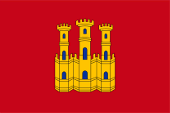 |
12.–13. Jahrhundert / 12th–13th century, |
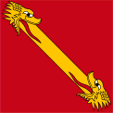 |
14.–16. Jahrhundert / 14th–16th century, |
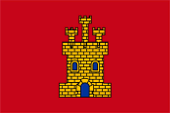 |
Flagge lokaler Nationalisten |
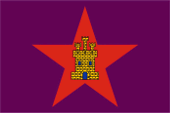 |
Flagge linksgerichteter lokaler Nationalisten |
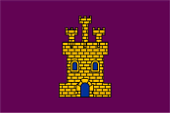 |
Flagge linksgerichteter lokaler Nationalisten |
| Die Flagge des alten Königreichs Kastilien war, wie damals üblich, eine Wappenflagge. Das heißt, eine Flagge die das Bild des Wappens des Landes (eigentlich des Herrschers) zeigte. Demzufolge ist das Flaggentuch einfarbig rot mit der Abbildung eines goldenen Kastells in der Mitte. In dieser Frühzeit der Flaggen waren diese eigentlich auch nicht so geformt wie unsere heutigen Flaggen. Die Flaggen glichen eher Wappen, die man mit der geraden Seite am Mast befestigte. Vom 14. bis zum 16. Jahrhundert verwendeten einige Könige Kastiliens (auch als die Kastilische Krone schon mit León verbunden war) eine rote Flagge mit zwei durch einen goldenen diagonalen Balken verbundenen Drachenköpfen, die Banda real de Castilla, ein wahrscheinlich auf eine rote Flagge mit einem goldenen Diagonalbalken zurückgehendes Banner. Sehr viele Könige hatten auch eigene persönliche Banner, immer rot, oft mit Darstellungen von Heiligen oder Kreuzen. Politische und kulturelle Gruppen welche heute die Identität Kastiliens erhalten und fördern wollen, oder gar die Unabhängigkeit des Landes wünschen, verwenden heutzutage häufig die einfarbige karmesinrote Flagge mit dem (oft stilisierten) Kastell, manchmal ergänzt um einen Löwen. Bei politisch linken Gruppen sind die Flaggen morado-/purpurfarben und oder zeigen zusätzlich einen roten Stern in der Mitte. |
The flag of the ancient
kingdom of Castile was, as was customary at the time, a heraldic flag. That
is a flag that showed the image of the coat of arms of the country (actually
the ruler). Consequently, the flag bunting is solid red with the image of a
golden castle in the center. In this early period of flags, they were actually not shaped like our flags today either. The flags were more like coats of arms, which were attached to the mast with the straight side. From the 14th to the 16th century, some kings of Castile (even when the Castilian Crown was already connected to León) used a red flag with two dragon heads connected by a golden diagonal bar, the Banda real de Castilla, a banner probably going back to a red flag with a golden diagonal bar. Very many kings also had their own personal banners, always red, often with representations of saints or crosses. Political and cultural groups that today want to preserve and promote the identity of Castile, or even desire the independence of the country, use nowadays often the plain crimson flag with the (often stylized) castle, sometimes supplemented by a lion. In the case of politically left-wing groups, the flags are morado/purple and or show additionally a red star in the center. |
| Quelle/Source: Wikipedia (ES), Flags of the World, Volker Preuß | |
Wappen – Coat of Arms: |
|
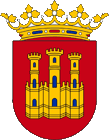 |
Wappen von Kastilien – coat of arms of Castile, Quelle/Source, nach/by: Wikipedia (ES) |
| Das Wappen des alten Königreichs Kastilien ist ein einfarbig roter Schild mit einem goldenen Kastell in der Mitte und wurde im Jahre 1165 erstmals beschrieben. Es ist ein redendes Wappen, denn das Wappenbild gibt den direkten Hinweis auf den Namen des Landes. Es kursieren sehr viele verschiedene Darstellungen der Burg, manchmal detailgetreu manchmal stilisiert, manchmal mit Tor manchmal ohne. Ein gemeinsames Merkmal sind jedoch immer drei Türme. |
The coat of arms of the
ancient Kingdom of Castile is a plain red shield with a golden castle in the
middle and was first described in 1165. It is a talking coat of arms because
the coat of arms provides a direct reference to the name of the country. There are many different depictions of the castle circulating, sometimes detailed, sometimes stylized, sometimes with a gate, sometimes without. However, one common feature is always three towers. |
| Quelle/Source: Wikipedia (EN), Volker Preuß | |
|
Karte der historischen Iberischen Königreiche – Map of the historic Iberian Kingdoms |
| ca. 1220 |
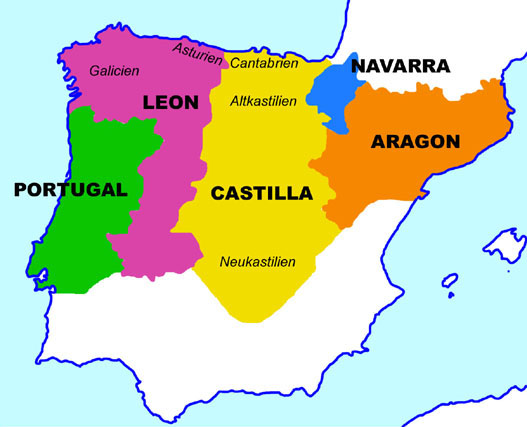 |
| Landkarte/map by: Volker Preuß |
| Zahlen und Fakten – Numbers and Facts: | |
|
|
|
|
|
|
|
|
| Die
Geschichte Kastiliens beginnt im Prinzip mit dem Königreich Asturien/León.
Jedoch entsteht Kastilien tatsächlich erst mit der Abspaltung von diesem
Königreich im Jahre 925. Frühzeit ·
Besiedlung durch Iberer (Kantabrer) Kastilien ist zwischen 1230 und 1833 Hauptbestandteil des Königreichs Kastilien-León.
|
| The
history of Castile starts in principle with the Kingdom of Asturia/León. But
in reality Castile came into being not until the secession from that kingdom
in the year 925. early age ·
settlement of Iberians (Cantabrians) Castile is between 1230 and 1479 the main component of the Kingdom of Castile-León.
|
| Quelle/Source: Wikipedia (ES), RetroBib Retrobibliothek, Volker Preuß |
| Der geographische Begriff "Kastilien" meint heute ein riesiges Territorium in Zentralspanien. Diese riesige Fläche wurde erst im Zusammenhang mit der Befreiung der Iberischen Halbinsel von den Moslems, der sogenannten Reconquista, und der damit bedingten Ausdehnung des Territoriums des ursprünglichen Kastilien definiert. Das ursprüngliche Kastilien hieß eigentlich Bardulien und war eine Art unbesetztes Niemandsland zwischen den Westgotischen (Asturien) und Arabischen Gebieten. Um die Kontrolle darüber zu bekommen wurden durch die Nachfahren der Westgoten zahlreiche Burgen oder eben Kastelle errichtet. Die vielen Burgen fanden letztlich ihren Niederschlag in einem neuen Namen für die ganze Landschaft, die eine Grafschaft des Königreiches Asturien-León wurde. Als Grafen wurden die Grafen von Burgos eingesetzt, die das Land im Jahre 925 von Asturien-León abspalteten. Die Gebiete nördlich des Zentralspanischen Iberischen Scheidegebirges (es erstreckt sich von Südwest nach Nordost) werden Altkastilien genannt und wurden bis etwa 1050 von den Arabern befreit. Die Gebiete südlich davon heißen Neukastilien und wurden bis etwa 1220 von den Arabern befreit. | The
geographic term "Castile" means today a huge territory in central Spain.
This enormous area got its name in context with the liberation of the
Iberian Peninsula from the Arabs – the so named Reconquista – and the in
this way coming expansion of the territory of the pristine Castile. The
pristine Castile was actually named as Bardulia and was something like an
unoccupied no man's land between the Western Goth (Asturia) and Arabian
territories. To get the control over it were planted numerous castles by the descendants of the Western Goth. So many castles find their expression in a new name for the whole countryside which became a county of the Kingdom of Asturia-León. As counts were installed the Counts of Burgos which separated the country from Asturia-León in the year 925. The areas northern the mountains of the mountains of the Central System (it extends from southwest to northeast) are named Old Castile and were liberated from the Arabs until 1050. The areas in the south of it are named New Castile and were liberated from the Arabs until 1220. |
| Quelle/Source: Wikipedia (DE), Volker Preuß | |